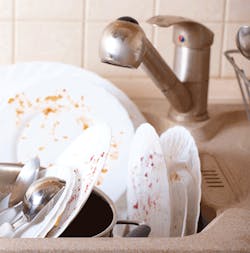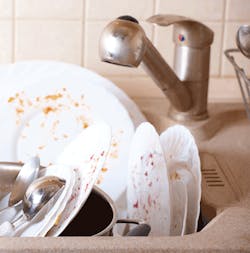Letting dirty dishes wait: Enzymatic presoaks 'delay' sterilization process for more important tasks
By Noel Kelsch, RDH, RDHAP, MS
Dishes just have to sit in the sink sometimes. Talking and just being with my friends and family will be more important than dirty dishes. Clearing the table for a game of Uno and letting the dishes soak is another most memorable moment in my life. One thing I have learned is that it is OK to put the dishes on hold, turn off the cell phone, and enjoy life. I always soak the dishes while I am enjoying my moments, so that I do not make my life "harder" with dried food stuck on the bowls and plates.
At times, other duties in the dental office get in the way of routines. Patients' lives include unexpected events, ranging from bursting abscesses to chipped teeth the day before weddings. Everything has to stop, and priorities are triaged. Getting people out of pain is the priority for the moment. Behind every task we perform in dentistry is a human being. Meeting their needs should always be our first priority.
While stepping away from other duties-just like dishes that I soak in the sink-there has to be an effective way of taking care for instruments in the dental setting while tending to the current priority. Allowing instruments to sit in the air can put staff at risk and allow blood and debris to dry making it difficult to remove, increasing the risk of sharps injuries.
Although the use of a presoak is not required, it is a way to save both time and effort. Presoaking or holding the instruments helps facilitate the cleaning process by preventing debris from drying.1 The purpose of a presoak is to keep bioburden/debris moist until you have time to clean the instruments in preparation for sterilization and to enzymatically break down blood and proteins. Dried-on blood and other matter can be very difficult to remove and expose the clinician to unneeded risks.
Cleaning must always occur before sterilization. The Centers for Disease Control and Prevention state that if debris is not removed, it will interfere with microbial inactivation and can compromise the disinfection or sterilization process. The use of a presoak can aid in assuring that debris is removed.2
Interestingly, using a presoak and then following with the use of either an ultrasonic or instrument washer has been found to be more effective for removal of blood than just using ultrasonic or instrument washer alone.3,4
Letting the dishes soak has made my life better and more enjoyable. I hope you find joy in your journey as you allow the instruments to be on "hold," and tend to the most important thing in your practice. Remember in all we do in dentistry, behind every task we perform, is a human being, the most important part of the equation. RDH
Five tips about enzymatic presoaks
1. It is important to read the instructions that come with the instruments you are considering presoaking. For example, some plastic instruments directions state they should not be presoaked.
2. The presoak should not be a disinfectant or sterilants. Using a disinfectant as a presoak can actually do more harm than good. Some disinfectants are corrosive to instruments, causing corrosion and rust over time.
3. Some great products contain enzymes that break down blood and other organic debris in the grooves and hinges of surgical instruments. Look for an enzymatic product.
4. Most solutions designed as a presoak have anti-corrosives and rust inhibitors in them. Look for a product that matches your needs. Look for a solution with a neutral pH.
5. Presoaks come in a bath form, and a spray or foam form. Both are effective. With a presoak solution/foam, the objects must be still considered contaminated. This process does not disinfect or sterilize.
NOEL BRANDON KELSCH, RDH, RDHAP, MS, is a syndicated columnist, writer, speaker, and cartoonist. She serves on the editorial review committee for the Organization for Safety, Asepsis and Prevention newsletter and has received many national awards. Kelsch owns her dental hygiene practice that focuses on access to care for all and helps facilitate the Simi Valley Free Dental Clinic. She has devoted much of her 35 years in dentistry to educating people about the devastating effects of methamphetamines and drug use. She is a past president of the California Dental Hygienists' Association.
References
1. Miller C, Palenik C. Infection Control and Management of Hazardous Materials for the Dental Team, 5th Edition: 340.
2. http://www.cdc.gov/oralhealth/infectioncontrol/faq/sterilization_cleaning.htm
3. Sanchez E, Macdonald G. Decontaminating dental instruments: testing the effectiveness of selected methods. J Am Dent Assoc. 1995;126(3):359-366.
4. Walker N, Burke FJ, Palenik CJ. Comparison of ultrasonic cleaning schemes: a pilot study. Prim Dent Care. 2006;13(2): 51-56.

